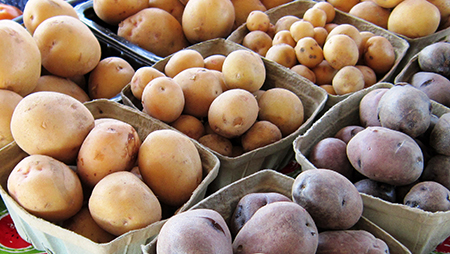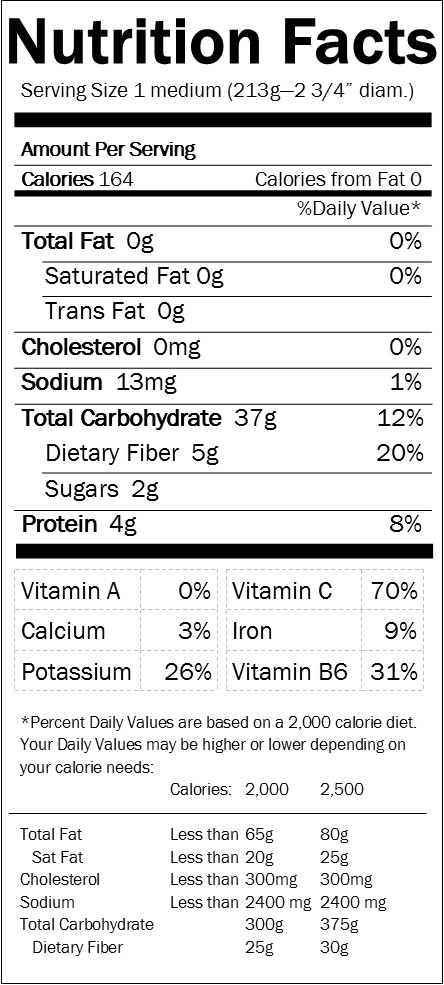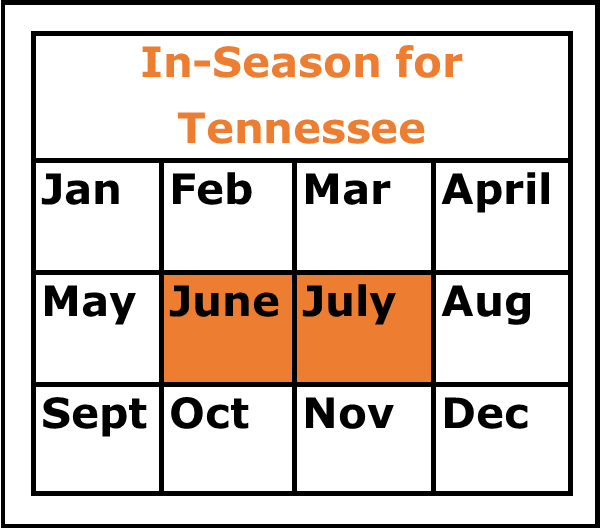
SELECTION
Look for potatoes that are firm with relatively smooth skins. They should not be withered or have sprouting at the “eyes” and shouldn’t have any large cuts or punctures or any signs of rot. Potatoes that have a green coloration to the skin should be avoided as this is a sign that they may contain the toxic alkaloid, solanine, which can impart an undesirable bitter taste as well as some undesirable health effects. You can cut away the green part but it’s best to avoid this in the first place.
Potatoes are sold fully mature as well as in the form of new potatoes, which are potatoes that are harvested before reaching full maturity. If cooking whole, you want to look for potatoes of similar size.
Choose potatoes according to their use:
Starchy Potatoes: The potatoes highest in starch are Russets (also called Idaho or baking potatoes). These cook up fluffy and are good for baking, roasting and mashing. They have thicker skins which are good for twice baked potatoes or potato skins.
Waxy Potatoes: Waxy potatoes hold their shape and are great for salads, boiling (as in plain or in soups and stews) and baking (as in casseroles and gratins). Red potatoes and fingerlings fall into this category.
All Purpose Potatoes: These are medium starch potatoes which can go either way. White and gold potatoes are examples of these. They have thinner skins than the baking potatoes.
(See the variety chart below for more information.)
STORAGE
Mature potatoes will store well for a couple of months under the right conditions. They like a cool (45 – 55 degrees F), dark place. Exposure to light will cause them to turn green and temperatures below 45 degrees F will cause the starch to turn to sugar which creates an undesirable taste. Don’t store them in the refrigerator. Plastic can cause them to retain moisture and create rot so use a brown paper bag or burlap. A common storage error is to keep potatoes and onions together – keep them away from each other. Check your potatoes often and remove any that are showing signs of spoilage as they will quickly affect the whole bag.
New potatoes will last only a week or so.
PREPARATION
Potatoes need to be washed. A lot of the nutrients are in the skin and just under the skin so leave it on if possible or peel just a thin layer off. Potatoes will take on a brown or pinkish color when cut, so cut up just before using or submerge in water if you are cutting up several or if they will stand for a little while before cooking (you can add a little lemon juice or vinegar). Potatoes can react with certain metals so it is best not to use a carbon steel knife or iron or aluminum cookware.
EDIBLE PARTS
The edible portion of the potato plant is the tuber (what we think of as the potato). It is actually a swollen part of an underground stem that is designed to feed the plant.
HOW TO TRY
Potatoes can be used in so many ways:
Baked – top with chili or shredded meat and cheese; twice bake by adding cheese and onion to the flesh and putting back in shell
Roasted – toss evenly cut up potatoes with a little olive oil and add salt and pepper or dried soup mix and roast on a baking sheet; add to the pan while roasting beef or pork; boil small, whole potatoes with the peel until tender and then smash on a baking sheet and roast until crispy with a little olive oil
Mashed – parsnips or turnips can be cooked with the potatoes and mashed together for extra flavor; mashed potatoes can also be layered with other vegetables like cooked carrots, peas or mushrooms between the layers of potato; try a shepherds pie by making your favorite pot pie mixture without the crust and spreading mashed potatoes over the top; stuff Portobello mushroom caps with mashed potatoes; turn mashed potatoes into potato patties; make gnocchi with left over mashed potatoes
Boiled – add to soups, stews and pot roasts; boil new potatoes whole and add a little olive oil with herbs and salt and pepper
Casseroles – layer sliced potatoes with cream or a cream sauce for scalloped potatoes; layer with a cheese sauce for au gratin potatoes; layer with a ground beef mixture for a main dish casserole; cube and combine with a cream soup and cheese; use hash browns in the bottom of an egg casserole (bake them a little first, then add the egg mixture); make a potato fritatta
Salads – make a French inspired Nicoise Salad with butter lettuce, tuna, hard boiled eggs, tomatoes, black olives, green beans and boiled new potatoes with a vinaigrette dressing; make a classic potato salad; use a ranch dressing for ranch potato salad; try a warm German potato salad with a vinegary dressing
VARIETIES
| TYPE | VARIETIES | CONTENT | USES |
|---|---|---|---|
| Russets | Russet Burbank, Ranger Russet, Umatilla Russet, Classic Russet, Premier Russet | Starchy | Baking Frying Mashing Roasting |
| Reds | Norland, Red La Soda, Chieftain, Sangre, Red Pontiac, Dakota Rose | Waxy | Boiling Soups and Stews Salads Casseroles/Gratins |
| Whites | Atlantic, Snowden, Dakota Pearl, Superior, Kennebec, Shepody, Cal White, Pike | All Purpose | Frying Mashing Roasting Boiling Soups and Stews Salads Casseroles/Gratins |
| Yellows | Yukon Gold, Innovator, Yukon Gem, Keuka Gold, Satina | All Purpose | Frying Mashing Roasting Boiling Soups and Stews Salads Casseroles/Gratins |
| Blue/Purple | Purple Majesty, All Blue, Mountain Rose, Purple Peruvian, Adirondack Blue | Waxy or All Purpose | Microwaving preserves color best |


Preservation
Cooking Techniques
- Baking
- Roasting
- Boiling
- Steaming
- Sauteing
- Pan Frying
- Deep Frying
Flavor Pairings
- Garlic
- Onions, Leeks, Shallots, Chives
- Bacon
- Cheese
- Rosemary
- Parsley
- Sage
- Thyme
- Oregano
- Dill